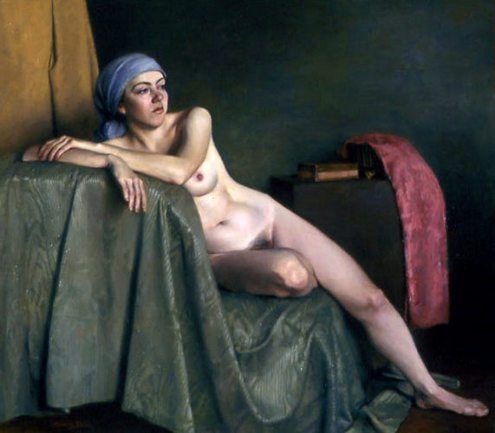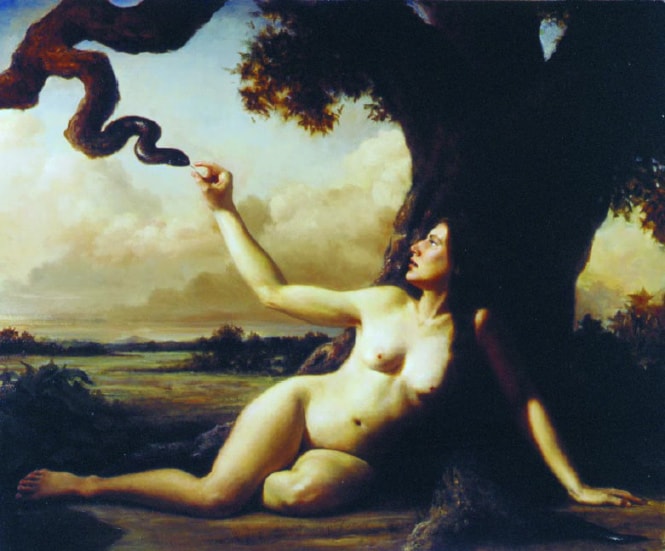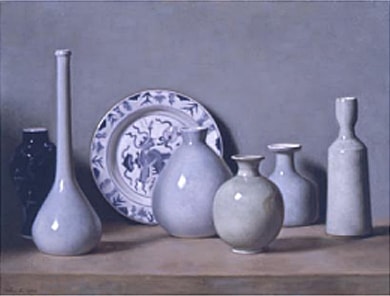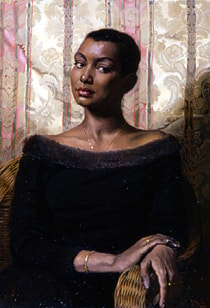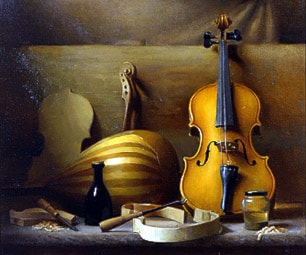Realism Revisited
Hirschl & Adler Galleries Decides On A Realism-Only Policy, Which Is Turning the Art World Up Side Down, or Rather, Right Side Up!
The galleries are currently showing Realism Revisited: The Florence Academy of Art
Hirschl & Adler Galleries of 21 East 70th Street, NYC, NY is one of the most established and respected galleries in the country, and it is among the first of the major galleries to recognize and participate in the fundamental and directional shift that is taking place in culture — a return to representational imagery in the visual arts. Their farseeing and perceptive Director of European Paintings, Dr. Gregory Hedberg, deserves considerable credit for championing the return of realism and for making it happen, with such shows as Realism Revisited: The Florence Academy of Art, now at Hirschl & Adler through October 4th (2003). It may be added that Dr. Hedberg has been at the forefront of this cultural re-awakening and committed to the value of fine representational art throughout his career. Indeed, even twenty years ago, he played a major role in making possible the 1984 retrospective on the art of William Bouguereau . The exhibition traveled from Paris, to Montreal, and then to Hartford's Wadsworth Atheneum where Dr. Hedberg was the Chief Curator of Paintings. The retrospective played a significant role in the serious re-evaluation of Bouguereau in our time, which led to Bouguereau's re-emergence as one of the greatest masters in art history.
Inherent to Hirschl & Adler's recognition of realism is their understanding that artists of stature must now be dedicated to the kind of training and skill acquisition that was expected of an artist in pervious centuries. In other words, the hard work of learning how to draw and paint. This skill must then be blended with meaningful subject matter and the uplifting quality of beauty to create an important work of art. Hirschl and Adler has seen the writing on the wall - people want to be moved and uplifted by art they can understand. They want to look at a work of art (and by the same reasoning, invest in a work of art) that they can see for themselves took skill, time, dedication, thought and emotional investment by the artist. They are tired of the gimmicks of the Twentieth Century and the short cuts that produce transitory artifacts that are fashionable for a moment in time, but are not really art. The modernist ideologies are no longer convincing this new generation of collectors and art enthusiasts, i.e. that abstract art is art, simply because they are told so. This audience is too sophisticated with the ways of marketing, too savvy to the rhetoric of modernist promotional verbiage, and too sincere in their attraction to art, to fall for the old line. They want to be able to see the genius with their own eyes in a language that they can be moved by and that they can respond to. This new generation wants to be both amazed by the skill of the artist and emotionally engaged with the painting.
Abstract art, for this new avant-garde generation, is experienced as boring and is not considered relevant. It may hold on ferociously for a while, but the future of art is a return to Realism. The movement grows stronger every day, with a younger generation willing and ready to learn. These artists know that abstract art has reached a dead end. Everything that could be done in abstraction has been done. Society's reaction is a great big yawn! There is nothing left to deconstruct. In fact, it now is time to rebuild. Hirschl and Adler see this so clearly, that they have now made it their policy to no longer represent abstract artists. They now represent a wide range of Realist artists who have obviously made the commitment to mastering the skills of drawing and painting in the Realist Tradition. The variety of styles and results are nothing short of amazing.
It makes sense that society would finally come to its senses, for the language of Realism is never boring. It is the language we use all the time, not only in our waking hours and in our dreams, but to make our lives interesting and meaningful. Realism has an infinite potential of subject matter and when paired with emotional content or a conviction of the validity of beauty, it is really the only form of serious art. It was the only form of art that truly mattered throughout history - for the language of Realism is not fashionable, it is universal, and will still be the visual language of the human race in the distant future, as it always has been.
Nothing could prove Hirschl & Adler's dedication to the return of Realism more than the present show and sale, Realism Revisited: The Florence Academy of Art. The exhibit represents twenty artists associated with The Florence Academy of Art, and the school is located, appropriately, in the birthplace of the Renaissance, Florence, Italy. Seventy-five realist works of art are on display and the artists are all faculty or alumni of The Florence Academy. Many of the works are from an exhibition of the same name held earlier this year in Germany at the Panorama Museum, and there are additional works in this NY show that were not in the Panorama show because they were painted expressly for the Hirschl & Adler exhibition. Included in the show are works by the founder and director of The Florence Academy, Daniel Graves, as well as paintings by Lotta Blokker, Robert Bodem, Paul S. Brown , Kamille Corry, Simona Dolci, Hunter Eddy, Louise Fenne, Adrian Gottlieb , Anthony Ackrill, Elena Arcangeli, Jurica Bedic, Simona Dolci, Maureen Hyde , David Larned, Urban Larsson , Jimmy Sanders, and Nelson White, Dana E. Levin, Angel Ramiro Sanchez and Paula Rubino.
Daniel Graves, who is an American artist, founded The Florence Academy of Art in 1991. He himself had mastered the skills of the academic system of training as a student of Richard Lack's at the Atelier Lack in Minneapolis. Atelier Lack used a system of rigorous training that was based on the historical methods used by artists for generations and that reached its peak in 19th century Europe in the ateliers of Bouguereau , Lefebvre , Bonnat , Vibert , Gérôme , and Julien. Daniel Graves and a fellow student of Lack's, Charles Cecil, opened the Cecil-Graves studio together in Florence in 1983. Eventually they went their separate ways, each now directors of their own successful academies. A third very successful academy in Florence is the Angel Academy directed by John Angel and his assistant Lynne Barton.
Daniel Graves has always felt it an important cultural responsibility to preserve the legacy of these methods of teaching, which were nearly lost to western art after World War II and throughout the 20th century. In founding The Florence Academy of Art, Graves took on a major responsibility, one that is now having a significant impact on culture. The school, which now boasts 120 artists in training, will send into the world a new kind of artist for our time, one empowered with all the skills of the past, an artist who can achieve what he or she envisions because of these broadened skills. Dan Graves, when speaking to Fred Ross, the Chairman of the Art Renewal Center (ARC), at the opening of the Realism Revisited show, told Mr. Ross that ARC has played a major role in the growth of the student body as a direct result of referrals to The Florence Academy by ARC. In fact, the Academy now has a long waiting list of students. A similar growth has occurred in Michael John Angel's Studio in both of his Ateliers in Florence and Toronto, Canada. Mr. Angel also gave ARC much of the credit for the tremendous growth of his school. The number of ateliers that offer high quality and intense art education in the academic method is on the rise. For a current list of these schools and master teachers go to ARC accredited ateliers. These schools will send into the world new generations of trained artists who will alter, and who are altering the course of history. The first real geniuses in a long time are emerging and will continue to emerge.
The artists represented in Realism Revisited have unique and different styles. They also share a humanistic view of art. As Dr. Hedberg says of their work, "The artists included in the Hirschl & Adler exhibition are all motivated by a Renaissance-inspired humanistic approach to their subjects. Much of the art in Realism Revisited dignifies the human experience while also paying careful attention to details such as color, light, shadow, form, and texture." Dr. Hedberg further clarifies this kind of realism as being different from Photo Realism when he explains, "Perhaps the best term to describe the dominant style of this exhibition is Old Master Realism. Unlike Photo Realism, which is based on the language of photography, the visual expression of these works comes from the appreciation, the long study, and, indeed, the language of Old Master painting" ... reinvented for modern sensibilities.
We have only to look at the painting, The Poet, by Daniel Graves to see what Gregory Hedberg means. The poet of this work is a distinctly modern and gaunt young man who is obviously in physical decline. But the aura of the painting gives off an Old Master glow with its dark and light contrasts and humanistic elements. Even if we know nothing of this poet, we can see pain, cynicism and sadness in his face, bathed in a golden light. His dark clothes emphasize the light and give it a spiritual quality. The hands of the poet are also bathed in this light. He holds a book of poetry against his chest with his left hand and cradles it with his right arm. This gives the viewer the impression of the book as being his child. His right hand clutches the sleeve of his left arm with tension and controlled effort. You understand that he is weak and that he is clutching his sleeve to help him hold up the book. We know now instinctively that this poet will not be with us in this world for long and we are touched. The emotion projected is strong, but not maudlin or melodramatic. It is a very respectful portrait.
Kamille Corry, with a very different style, more akin to the Pre-Raphaelites, yet unique and with her own voice, says of her own feelings when she first began to study at The Florence Academy, "I rejected it [the training] at first because I thought it was too limiting or restrictive. Once I did it, it was exactly the opposite. I was really learning something." She further emphasizes, "It opened up a whole new world and once I started studying ... that was it. I had no desire to ever go back and slap paint on fabric or throw it at a canvas and call it art. I wanted to express myself using the human figure or nature because that's what inspires me: a beautiful landscape, an expressive face or hands, the colors of rock in the Utah desert." We understand her love of landscape and color as we view her sensual painting Lotus, 2001. We are immediately drawn to her creation of beauty because of her glorious use of warm and life affirming color and light. In this painting, Corry's image of a lovely young woman, curled and asleep, with her hands folded towards her face in a partial fetal position, is vulnerable, lush and sensitive. She paints the human figure as if it were a human landscape, the body with its peaks and valleys kissed by an earthy sun. This sensual and beautiful piece reminds one of Leighton's Flaming June, because of the curled position of the sleeping model and the lushness of her skin tones, but the painting has a startling and modern sensibility and makes one feels a bit like a voyeur.
Portrait of Donald Sutphin and his Studio is once again a completely different kind of Realism. The artist, Jimmy Sanders, has given his full attention to detail without the composition becoming busy. Sanders shows the print maker immersed in his work and in turn immersed in his studio. All the tools of the craft are part of the print maker's life and hence part of his portrait. The light and color are more evenly distributed across the canvas than in most of the other paintings in the show. It is as if the entire room was the portrait. There is also historical interest to the detail as all that is shown is accurate.
Hunter Eddy's Liutaio's Workshop is again a return to an Old Master's palette. A respect for the skill it takes to build instruments is made alive in this "portrait" of a violin and lute. There is a harmonious monochromatic choice of coloring, but the coloring is exquisite, a tour-de-force in golden browns. This harmonious color scheme fits well with the concept of classical harmonious music. The tools and unfinished parts of instruments that form a secondary structure to the painting, only add to our impression of the skill that is required to utilize these tools and parts in order to create such beautiful and functional musical instruments ... instruments that in the right hands can truly sing.
Paul S. Brown's sensitive self-portrait is truly engaging. He manages to paint himself without any egotistical overtones. How has he accomplished this? The chiaroscuro is intense, with the weight and bulky shape of his solid black coat making his lit face even more expressive. His eyes look directly into the viewer's and at the same time look past the viewer. He sees you and is also in a faraway place — the place where creativity is found, perhaps. His shadow on the wall, with a small piece of light breaking up the blacks between the edge of the coat and the shadow, creates depth and compositional interest and balance. The portrait has an intensity to it that is also elegant and subtle, reminding one of a John Singer Sargent or Whistler , but yet definitively contemporary.
This is an exciting time to be alive for the young realist artist, and also for those older artists, who have stood the test of time and held fast to the belief that an artist must know how to observe, draw and paint the world in which we live if he or she wants to be called an artist. They have lived to see their commitment appreciated, their artwork respected, and their knowledge preserved and perpetuated. A new generation of artists is being trained and prepared to enter the art world with power and grace and with the conviction that they will make great artwork and play an important role in the future of art. What could be more uplifting? This is more than Realism Re-Visited; this is the birth of a whole new movement, a full circle return to the inevitable course of artistic evolution that was interrupted and damaged in the Twentieth Century.
Sources and important links to articles on this subject
- Realism Revisited: The Florence Academy of Art, Panorama Museum, Bad Frankenhausen, Germany 2003, can be obtained from Hirsch & Adler Galleries
- Hirschl & Adler Galleries
- Tradition in the 21st Century [PDF], by Daniel Graves


